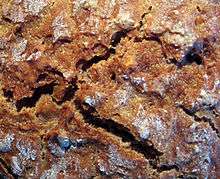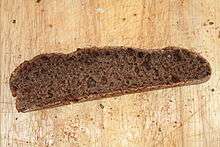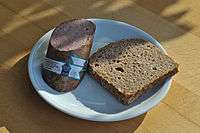Brown bread
 | |
| Type | Bread |
|---|---|
| Main ingredients | Whole grain flour (usually rye or wheat) or molasses or coffee |
| 260 kcal (1089 kJ) | |
|
| |
Brown bread is a designation often given to breads made with significant amounts of whole grain flour, usually wheat, and sometimes dark-colored ingredients such as molasses or coffee. In Canada and the United Kingdom it simply refers to wholemeal or whole wheat bread, except in the Maritimes, where it implies bread made with molasses.
Whole wheat flours that contain raw wheat germ, instead of toasted germ, have higher levels of glutathione, and thus are said to result in lower loaf volumes.[1]
History

In Ireland, during the Famine, prior to 1848, brown bread was handed out to the poor.[2] In England, brown bread was made from brown meal.[3] Around and prior to the year 1845, brown meal was considered a less desirable grain product, and was priced accordingly. However, by 1865, due to recently discovered health benefits of bran, brown meal's London price had increased to a point often greater than that of fine flour.[4]
Flour milling

Historically, brown meal was what remained after about 90% of the coarse, outer bran and 74% of pure endosperm or fine flour was removed from the whole grain.[5] Using slightly different extraction numbers, brown meal, representing 20% of the whole grain, was itself composed of about 15% fine bran and 85% white flour.[6] In 1848 it was asserted grain millers knew only of bran and endosperm,[7] but by 1912 it was more widely known that brown meal included the germ.[3]
Colour
The brown color of whole grain breads is caused by cerealine, a discovery attributed to Hippolyte Mège-Mouriès of France.[5][8] Cerealine, considered by Mouriès an active principal or ferment similar in action to diastase,[8] came from the cereal layer of rectangular cells that millers considered a part of bran: later it was alternatively called the aleurone layer.[9] In a statement attributed to Mouriès, if the cerealine is neutralized, white bread can be made from bran-containing flour.[5]
Regional varieties
- Home-made Irish brown soda bread
 Zeppelinwurst with brown bread
Zeppelinwurst with brown bread
Irish brown bread
Irish wheaten bread is a form of Irish soda bread made with whole-wheat flour.
Ideal brown bread
Ideal brown bread was made from brown meal, yeast, salt, and water.[10]
Boston brown bread
New England or Boston brown bread is a type of dark, slightly sweet steamed bread (usually a quick bread) popular in New England. It is cooked by steam in a can, or cylindrical pan.
Boston brown bread's colour comes from a mixture of flours, usually a mix of several of the following: cornmeal, rye, whole wheat, graham flour, and from the addition of sweeteners like molasses and maple syrup. Leavening most often comes from baking soda (sodium bicarbonate) though a few recipes use yeast. Raisins are often added. The batter is poured into a can, and steamed in a kettle. While most variations are quick breads, and can be made in less than an hour, several commercial brands are available. Brown bread is somewhat seasonal, being served mostly in fall and winter, and is frequently served with baked beans.
Brown bread is closely related to an earlier bread known as "Rye n Injun" (from "Indian" cornmeal) or "thirded" bread from its use of rye, cornmeal and wheat flours. Unlike modern Boston brown bread, thirded bread is generally yeast-raised and baked rather than steamed.
See also
- Anadama bread, a yeast bread of New England made with wheat, cornmeal, molasses, tan to brown in colour
- List of breads
- Malt loaf
- Pumpernickel, a dark brown bread of Germany
- Whole wheat bread
References
- ↑ Paula I. Figoni (2010). How Baking Works: Exploring the Fundamentals of Baking Science. New York: Wiley. pp. 147–150. ISBN 0-470-39267-3. Retrieved April 17, 2011.
Glutathione is also found in whole wheat flour, in particular in the wheat germ. ... Toasted wheat germ will not have the same high glutathione activity as raw wheat germ, since glutathione is inactivated by heat. ... If glutathione is not first destroyed, bread dough softens and becomes slack, and oven spring decreases. The result is lower loaf volume and coarser texture.
- ↑ John Saunders, ed. (1848). The People's journal. IV. London: The People's Journal Office. p. 200. Retrieved April 15, 2011.
I passed along and beheld a dense mass of wretched starving people,---men, women, and children, gathered in front of a shed, from which rations of brown bread and stirabout were served out to the poor.
- 1 2 Percy A. Amos (1912). Processes of flour manufacture. New York, Bombay, and Calcutta: Longman, Green, and Co. p. 14. Retrieved April 12, 2011.
By allowing the germ and all but the outer, coarser layers of broad bran to mix in with the flour, we get the sweet-tasting brown meal producing the brown bread so much in favour amongst sections of the community.
- ↑ Edward Smith (1865). Practical dietary for families, schools, and the laboring classes. London: Walton and Maberly. p. 36. Retrieved April 15, 2011.
- 1 2 3 Edward Livingston Youmans (1859). The hand-book of household science. New York: D. Appleton and Company. p. 277. Retrieved April 15, 2011.
He grinds wheat so as to separate it into about 74 per cent. of fine flour, 16 of brown meal, and 10 of bran.
- ↑ Jacob Bell, ed. (1857–58). The Pharmaceutical journal and Transactions. XVII. London: John Churchill. pp. 276–277. Retrieved April 2011.
The Parisian white bread is prepared with the finest flour (1re marque), which does not contain any bran. If 100 parts wheat yield 70 parts of this flour, the remainder will consist of ten parts bran and 20 parts coarse brown meal, this latter consisting of three parts fine bran and 17 parts white flour.
Check date values in:|access-date=(help) - ↑ John Saunders, ed. (1848). The People's journal. IV. London: The People's Journal Office. p. 42(IA1). Retrieved April 15, 2011.
Professor Johnston remarks that—'The grain of wheat consists of two parts, with which the miller is familiar—the inner grain and the skin that covers it. The inner grain gives the pure wheat flour; the skin when separated, forms the bran.'
- 1 2 John and Charles Watt, ed. (1857). The Chemist: a monthly journal of Chemical and Physical Science. IV. London: Alexander Watt. pp. 488–539.
... cerealine...
- ↑ Helen Woodard Atwater (1900). Bread and the principles of bread making. Washington: Government Printing Office. p. 9.
- ↑ Robert Wells (1903). The new system of making bread. Manchester: Abel Heywood & Son. p. 134.
Good, palatable, ideal brown bread
External links
- Fannie Farmer 1918 recipe for brown bread
- Recipe for brown bread
- Epicurious recipe for Irish brown bread
